
I've always had an affinity for any type of seafood curry. The flavors are quite different from a meat curry. Seafood curries have varying elements that make up the right taste, but not everyone knows how to achieve the equilibrium of the acid and tang that is needed for these type of curries. It's for sure a balancing act.

Bounjal is a method of cooking curry where the curry sauce is dried down until it sears onto the meat, seafood, or vegetable you are bounjaying. The dish ends up being heavily coated in masala/curry powder spices and is usually enjoyed as cutters (appetizers) or with dhal and rice. I particularly loved my mom's bounjal shrimp because she used white belly shrimp. It is a difficult shrimp to source, I've only found it at West Indian grocery stores. Any small or medium shrimp can work for this recipe.
About the White Belly Shrimp
White belly shrimp is a very tiny shrimp found in the brown muddy waters of Guyana, not dirty water, just brown water. It can be consumed with the shell on since it is soft and quite thin. It is very tasty once fried as the skin turns slightly crisp. White belly shrimp is quite prevalent in Guyana due to the natural aquatic environment it grows in.
Because Guyana is one of the countries that the Amazon river drains from, the water begins to get muddy as it carries along sediment and becomes brown by the time it reaches Guyana’s coastline. This type of water which is unique to Guyana and many other countries like Bolivia, Colombia, and Ecuador, contains many nutrients for white belly shrimp. My husband, who is from Trinidad, mentioned he had never eaten this type of shrimp growing up, but after a little research, we realized it was because the waters surrounding many Caribbean islands are not as nutritious for a crustacean such as white belly shrimp.
White belly is best caught during January – May with peaks during March and April, so if you begin to see price fluctuations during the off season, you’ll know why! I found a very old article online that discusses the fisheries of Guyana, it also shows a diagram of where white belly shrimp can be found on the ocean floor. Unfortunately the pdf containing the diagram has been removed from the site, but if anyone comes across anymore info on white belly, please leave it down in the comment section.

As I've mentioned before, one of the reasons I love posting on instagram is because I get instant feedback. When I posted this photo a few weeks ago, many of you messaged saying you have trouble getting your shrimp curry just right. I suspect that some element might be left out and your tastebuds are wanting one of these 5 components.
What makes a good seafood curry?
- Sourness - Green, (unripened) mango or mango powders provide this taste. Tamarind is also used to achieve the tartness associated with fish/shrimp curries.
- Acidity - Fresh tomatoes are a must for fish/shrimp curry. It melts well and distributes a mild acidity to the gravy. The tomato paste in this recipe is preferred for color not so much acidity.
- Salt - If there isn't enough salt, none of these tastes will balance.
- Hot pepper - Although curry already has a lot spices, cooking with fresh hot peppers lends yet another layer of flavor.
- Masala/Curry Powder ratio - A rule of thumb for cooking shrimp/fish/crab curries is to have more curry powder than masala in the mixture. Meats, especially red meat needs more masala to bring out its flavor. Learning how to balance this ratio comes with practice so be patient with yourself if you don't get it right the first time.
For this recipe, my souring agent of choice is green (unripened) mango. Make sure the mango you use is not even in the slightest bit ripe, otherwise the curry will not have a sour taste. Green mango should be pale when you cut into it. If there is a tinge of yellow in the flesh, the mango will not be sour.

White belly shrimp can have a strong and unpleasant smell, so it needs to be soaked with water and a lot of fresh lime juice.

Because this shrimp is so small, it can fall through a standard colander. I recommend using a mesh strainer when draining the water and rinsing.

Add enough water to make a loose curry paste. If the paste is more yellow in color, the curry will also have a similar color.

Tips:
- Leave the skin on the mango so it doesn't melt completely into the curry.
- White belly shrimp can have a strong or unpleasant odor so a lot of lime juice is needed to help cut the rank. This type of shrimp also does not need to be peeled. It is so tiny that the shell is quite thin and crisps up once cooked.
- If using white belly shrimp for this recipe, after washing shrimp, make sure to drain in a mesh strainer or one with very small holes. Draining water by hand will result in shrimp falling down the drain.
- I do not season the shrimp prior to cooking because the masala mixture is quite heavy and provides enough seasoning overall.

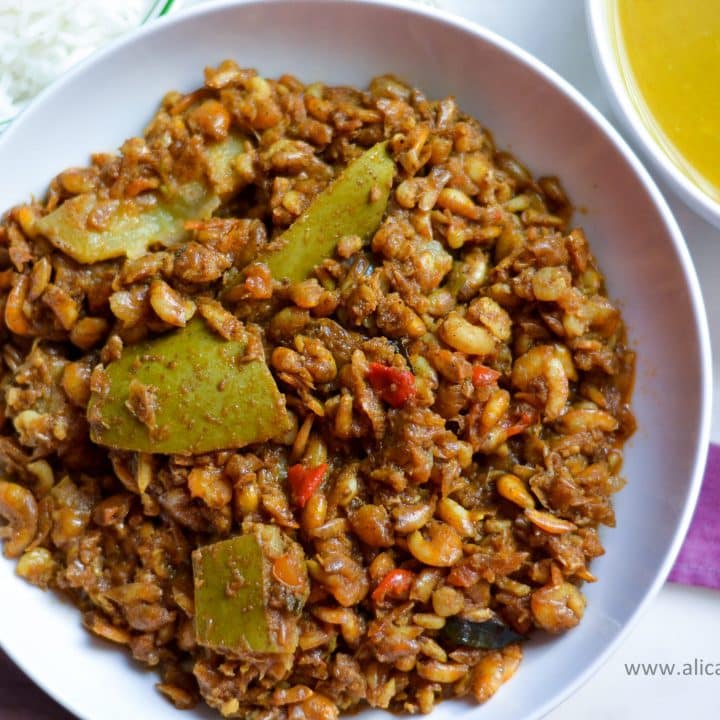
Bounjal Shrimp Curry
Ingredients
- 3-4lbs small-medium raw shrimp (peeled and deveined, if not using white belly shrimp)
- 2 limes
- 2 heaping tablespoons onion-garlic-hot pepper paste + enough water to mix
- 2 tablespoons madras curry powder
- 1 ½ tablespoons garam masala
- ½ teaspoon geera (roasted cumin)
- 2 teaspoon tomato paste
- 3 tablespoon neutral oil for cooking like avocado, grapeseed, Light EVOO
- 5-6 curry leaves
- 3-4 wiri wiri peppers or 1-2 scotch bonnets
- ½ green (unripened) mango (about 6, 2-in pieces)
- 2 plum tomatoes (1 cup, chopped)
- ¼ cup water
- 1 ½ teaspoon salt, more to taste
- 2 scallion stems, finely minced
Instructions
If using white belly shrimp: Place shrimp in a mixing bowl to wash and prep. Squeeze the juice of two limes over the shrimp and mix using a spoon. Pour enough water to cover the shrimp. Let soak for 15-20 minutes. Remove limes, and place shrimp in a mesh strainer. Rinse shrimp with cold water for a couple of minutes and set aside until ready to cook.
If using small to medium-sized shrimp: Place shrimp in a mixing bowl to wash and prep. Squeeze the juice of one lime over the shrimp and add enough water to cover the shrimp. Let it sit in the water for 2-3 minutes, then rinse by draining the water and adding fresh water again; swish the shrimp with more fresh water, then drain again. Since this size shrimp is larger than white belly shrimp, a mesh strainer is unnecessary. Dry with a paper towel and set aside until ready to cook. Note: this type of shrimp cooks quickly, and if it sits in the lime water for too long, the acid will begin to tenderize and tear the flesh, so rinsing quickly is important.
- Make onion-garlic-hot pepper paste by blending one chopped yellow onion, one head of garlic, and 3-4 wiri wiri peppers in a blender with a little water. Reserve 2 heaping tablespoon for the recipe and refrigerate the remainder.
- Make masala paste-In a small mixing bowl, add curry powder, masala, geera, and tomato paste to the 2 tablespoon onion-garlic-hot pepper paste. Add enough water (a few tablespoons) to make a loose paste. Set aside.
- Chop scallions, green mango (leaving the skin on), and plum tomatoes. Set aside.
- Fry the masala paste: Pour oil into a karahi or heavy-bottomed pot on medium heat. When the oil is hot after a minute or two, add curry leaves and fry for a minute or until you can smell the curry leaves, and the oil is fragrant. Add the masala paste and fry for a few minutes until it turns a shade darker than when you first added it; it will also look dry but should not be burnt where it sticks to the pot.
- Cook the shrimp: Add shrimp, mango, tomatoes, wiri wiri peppers, salt, and water. Let the mixture cook for about 15-20 minutes on medium-high heat until it begins to look dry when the masala coats the shrimp. Add scallions when the curry is done, then toss them together.
Notes
- 2 teaspoons tamarind pulp may be substituted in place of green mango.
- Any heavy-bottomed pot/pan may be used in place of a kahari. I prefer using an enamel cast iron Dutch oven.


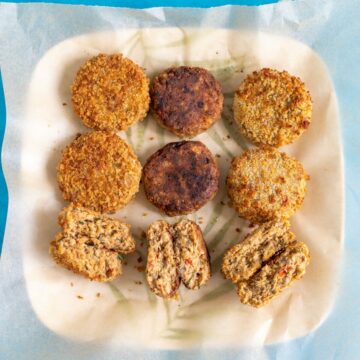
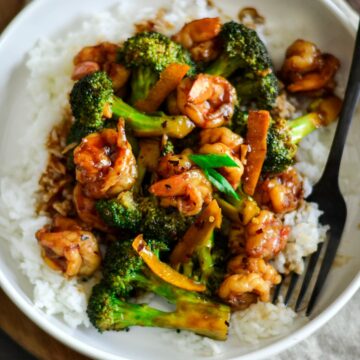
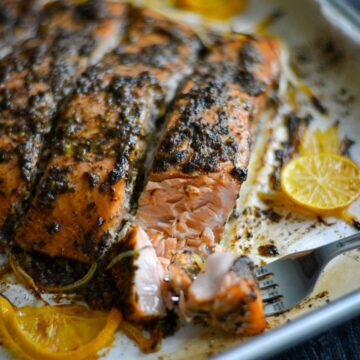
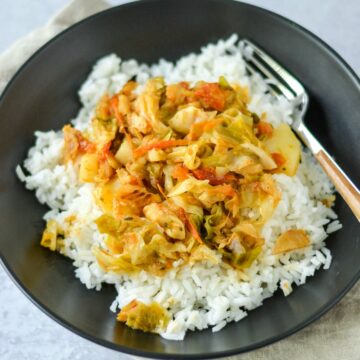
Kami | Life with Kami says
The serving size you recommended says 3-4, I don't think that will fly at my house. That's a Kami's serving alone! It's one of my favorite curry with roti 🙂
Mary says
Stop. You're making me hungry LoL. That is some feat sourcing white belly shrimp and a green mango.We don't get that out west where I am. I did see a lot of dried shrimp in the asian stores but they are so expensive. Loved all the history of the source of the shrimp and our waterways. learned something I didn't know.
Well done Alica. Another winner for sure.
Andrea says
This post is so interesting as I've never heard of white belly shrimp & the term bounjal. My home country (Grenada) doesn't have those shrimps & from traveling to Trinidad, (my 2nd home) on different occasions, I've only known one type of shrimp of different sizes.
The art of how to curry meat or fish & develop vast caribbean flavours, has always been something I wanted to master in. I think I've learnt to curry vegetables & meat well, but yet still learning about seafood. This is such a mind opening post for learning. Keep posting great stuff!!??
Jaswattie says
Where could I find white belly shrimp that belongs to Guyana and I’m from Toronto Ontario canada
Alica says
Hi, I've only seen this shrimp at West Indian grocery stores. It comes frozen in small bags.
Adrian says
This reply might be aged but hope it helps others as well.
Depends on which part of Toronto..where I'm from in the east end, you can get it at M&S at Nelson and Bellamy, Charlie's at Morningside and Sheppard, Freshland supermarket sometimes have, Fusion sometimes. One Love in Oshawa and most of the "smaller" west Indian grocery store. It's tricky to find. These are the locations I know about but there could be more
Alica says
Thanks for the recommendations, I'm sure my Canadian readers will find it helpful!
Patrick Mendonca says
I used your recipe and it was awesome.My curry never tasted so good.
Thanks for sharing.
Alica says
Hi Patrick,
That's wonderful! Thanks for your comment ?.